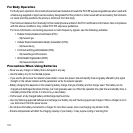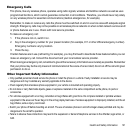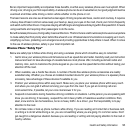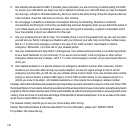Health and Safety Information 125
But an important responsibility accompanies those benefits, one that every wireless phone user must uphold. When
driving a car, driving is your first responsibility. A wireless phone can be an invaluable tool, but good judgment must be
exercised at all times while driving a motor vehicle whether on the phone or not.
The basic lessons are ones we all learned as teenagers. Driving requires alertness, caution and courtesy. It requires
a heavy dose of basic common sense-keep your head up, keep your eyes on the road, check your mirrors frequently
and watch out for other drivers. It requires obeying all traffic signs and signals and staying within the speed limit. It means
using seat belts and requiring other passengers to do the same.
But with wireless phone use, driving safely means a little more. This brochure is a call to wireless phone users everywhere
to make safety their first priority when behind the wheel of a car. Wireless telecommunications is keeping us in touch,
simplifying our lives, protecting us in emergencies and providing opportunities to help others in need. When it comes
to the use of wireless phones, safety is your most important call.
Wireless Phone “Safety Tips”
Below are safety tips to follow while driving and using a wireless phone which should be easy to remember:
1. Get to know your wireless phone and its features such as speed dial and redial. Carefully read your instruction
manual and learn to take advantage of valuable features most phones offer, including automatic redial and
memory. Also, work to memorize the phone keypad so you can use the speed dial function without taking your
attention off the road.
2. When available, use a hands free device. A number of hands free wireless phone accessories are readily
available today. Whether you choose an installed mounted device for your wireless phone or a speaker phone
accessory, take advantage of these devices if available to you.
3. Position your wireless phone within easy reach. Make sure you place your wireless phone within easy reach
and where you can grab it without removing your eyes from the road. If you get an incoming call at an
inconvenient time, if possible, let your voice mail answer it for you.
4. Suspend conversations during hazardous driving conditions or situations. Let the person you are speaking with
know you are driving; if necessary, suspend the call in heavy traffic or hazardous weather conditions. Rain,
sleet, snow and ice can be hazardous, but so is heavy traffic. As a driver, your first responsibility is to pay
attention to the road.
5. Do not take notes or look up phone numbers while driving. If you are reading an Contact list or business card,
or writing a to do list while driving a car, you are not watching where you are going. It’s common sense. Don’t
get caught in a dangerous situation because you are reading or writing and not paying attention to the road or
nearby vehicles.


















